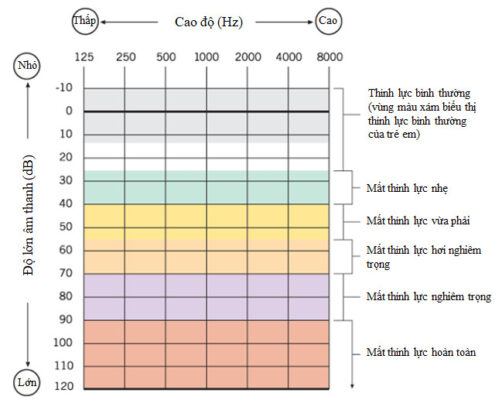Training activities
Hearing loss explain

How does hearing work?
Hearing is a complex process that involves many parts of the ear working together to convert sound waves into information that is sent to the brain where that sound is interpreted and understood.
The ear consists of three main parts:
- The outer ears: the external ears and the ears canal
- The middle ears: the ears drums and very small bones that make up the ossicular chain, the malious, incus and stapes
- The inner ears: the cochlea and auditory nerve
Simply put, sound, which includes speech, enters the ears and is received and moved along a defined pathway to the auditory areas (or hearing centers) of the brain where that sound is understood. The different parts of the ear and rest of the auditory pathway act as way stations by reacting to and moving sound to the next way station in the hearing system. Any time there is a disruption to the travel of sound as it makes its way to its final destination, the auditory areas of the brain, the result is a hearing loss or disorder. The outer ear, middle ear, inner ear and auditory centers of the brain all make up the auditory system. Here’s how it works:
- The outer earcollects sound waves moving through the air and directs them to the eardrum.
- The eardrumvibrates with sound.
- Sound vibrationsmove from the eardrum through the ossicles (bones in the middle ear) to the cochlea.
- Sound vibrationscause the fluid and tiny hair cells inside the cochlea to move.
- Hair cell movement creates neural signals, which are picked up by the auditory (hearing) nerve.
- The auditory nervesends signals to the auditory areas (or hearing centers) of the brain, where they are interpreted as sounds and speech.
So, while sound is received by the ear, it is actually heard in the brain.
What is speech banana?
The speech banana is a term used to describe the area where the sounds of human speech (called phonemes), appear on an audiogram (graph of an individual’s hearing thresholds). When the phonemes are plotted out on the audiogram they make the shape of a banana. Therefore, audiologists and other speech professionals refer to that area as the “speech banana.” While many other sounds fall outside of the speech banana, audiologists are most concerned with the frequencies within the speech banana because a hearing loss in those frequencies can affect a child’s ability to learn language.
What causes hearing loss?
Hearing loss may result if any part of the hearing process along the auditory pathway is not functioning properly, which causes a disruption to sound as it travels towards the brain. The cause can be genetic, environmental, due to illness or even unexplained.
- Genetic– In more than 50 percent of pediatric hearing loss cases, it is believed that genetic factors are the cause. Genetic or hereditary hearing loss occurs when a gene from one or both of the parents affects any portion of the outer, middle or inner ear, causing varying degrees of hearing loss.
- Prenatal Exposure – In some cases, an in utero infection, illness, or toxin during the mother’s pregnancy can be passed on to a baby in utero and cause hearing loss.
- Perinatal Experiences– Procedures performed or medications used to save a baby’s life in an emergency (such as use of a ventilator or a strong antibiotic) can also affect hearing.
- Acquired Hearing Loss– When hearing loss occurs after birth, it is often due to factors such as:
- Chronic ear infections, also called otitis media:A common issue for many children and typically causes only temporary hearing loss. However, prolonged issues without treatment or repeated cases can affect hearing and cause more permanent damage.
- Ototoxic drugs:Usually prescribed to treat serious problems such as meningitis, this class of medications can affect hearing.
- Disease: Conditions such as otosclerosis, Ménière’s disease, meningitis and mumps can affect hearing. The impact on hearing varies depending on the cause, severity and duration of treatment.
- Head injury:Head trauma can potentially have a dramatic effect on hearing, especially in children who are still growing.
- Perforated eardrum:Ear infections, head trauma or the insertion of a foreign object into the ear (small toys, pens, cotton swabs, ear candles, etc.) can damage the eardrum. Oftentimes, a perforated or torn eardrum will heal with proper treatment and the accompanying hearing loss may be temporary.
- Unknown Causes– In some cases, it may be impossible to pinpoint why your child is deaf or hard of hearing. Regardless of the cause, it is important to act quickly to confirm a diagnosis, and ensure your child has auditory access to speech and language as early and consistently as possible.
Is all hearing loss the same?
No. There are actually five different types of hearing loss:
- Conductive:Occurs when there is a condition of the outer or middle ear that prevents sound from reaching the inner ear and brain. Causes can include blockage of the outer ear or ear canal, an ear infection with fluid, or a malformation of the outer or middle ear. The hearing loss may be temporary or treatable with medication or surgery. If the condition cannot be addressed through medication or surgery, many people with conductive hearing loss may benefit from hearing aids.
- Sensorineural:Usually the result of a problem with the cochlea, either through malformation or damage. Damage can occur from infections such as meningitis, or as a side effect of certain ototoxic medications (toxic to parts of the ear). This type of hearing loss typically cannot be treated with medication. Options such as hearing aids, middle ear implants or cochlear implants vary depending on the cause and severity of the hearing loss. Having your child fitted with appropriate hearing devices as quickly as possible following diagnosis is an important step towards improving your child’s access to sound.
- Mixed:A combination of conductive and sensorineural hearing loss.
- Neural:A rare condition resulting from damage or malformation to the auditory (hearing) nerve that connects the cochlea (inner ear) to the brain. The hearing loss is usually profound and permanent. Traditional treatment options like hearing aids or cochlear implants are typically not viable because in cases of neural hearing loss, the auditory nerve is not able to transmit information to the brain. In some cases, auditory brainstem implants have been utilized with limited success.
- Auditory Neuropathy:Occurs when sound travels through to the inner ear normally, but further transmission of sound to the brain is impaired. Children and adults with Auditory Neuropathy Spectrum Disorder (ANSD) can have hearing loss that ranges from mild to severe and the ability to understand speech varies widely. This type of hearing loss can be very difficult to diagnose as hearing abilities may appear to change back and forth, making it particularly important that a pediatric audiologist with experience in diagnosing ANSD is consulted.
